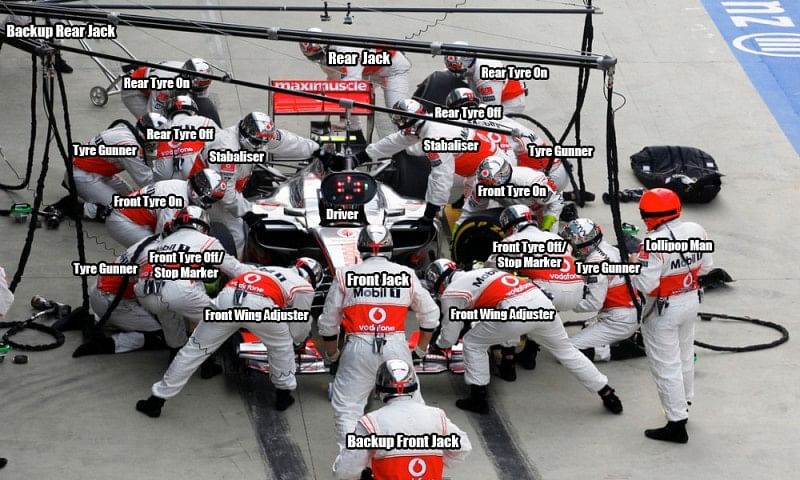How are Formula One teams saving the lives of new-born babies?
If you want to dramatically improve the performance of your team,
then it is vital to look outside your industry
Why?
Because if you look outside your industry, you’re likely to pick up tools, techniques and practices (TTPs) that other people haven’t thought of yet – and it is these TTPs applied in your industry that have the potential to revolutionise how you and your team performs.
In business most people will often look at the market leader and try and emulate what they do. They will try to understand what made these people successful and then emulate it. Think about how many people idolise Steve Jobs.
The problem with this approach is that it only has the potential to take you as far as the current market leader because you’re trying to copy their recipe. You’re making the assumption that if ‘you do what they do – you’ll get the same result’. This is a flawed assumption that at best will make you a ‘plastic version’ of the market leader.
Steve Jobs didn’t copy Nokia
The Neonatal unit at Cardiff University have recently been working with the Williams Formula One Team. On the face of it, this might seem like a strange match but scratch the surface and you’ll find that these teams have more in common than you might think.
Williams have recorded the fastest pit stops in all four races this season. This is an example of a team that are very good at working quickly and efficiently in an environment where space is limited.
After a series of costly mistakes last season, Williams hired a human performance specialist who worked with the crew to fine tune their ability to work as a team. The specialist had previously worked at Cardiff Hospital.
When you think about it, both of these teams have to work quickly to achieve a common aim. They’re under pressure because time is limited and failure can have significant consequences.
Although they’re working towards a completely different outcome, the environment, the pressure and the lack of time are universal challenges.
Anyone who has fought in Afghanistan will know what it is like to work under pressure to achieve something – to make a goal happen. But we’re fortunate – we’ve been taught how to deal with pressure.
Pressure is pressure – it doesn’t matter whether your life is on the line or you’re about to deliver a big presentation.
We all respond to it in our own individual ways. Our responses are shaped by the context of the situation, our experience and how much ‘cumulative stress’ we’re under.
So what were some of the practical lessons that the Neonatal Unit took from the Williams team?
Firstly, they organised their equipment to make sure that it could be found as quickly as possible. The trolley that they use was ‘streamlined’ to make it quick and easy to find what you want – when seconds count, you can’t afford to be looking for kit.

They also mapped out the ‘floor space’ to show where everyone should work. It sounds over the top but this level of clarity makes it easy for people to perform their jobs to the required standard. This is a form of standardisation.
At the USMC Depot at Parris Island, the new recruits are required to stand on the famous yellow footprints before they enter the camp. This is not about control – it is about clarity – making expectations so clear that people know where they stand… literally.
Leaders create clarity – they make it easier for people to ‘get it right’.

Standards aren’t just about ‘Risk Assessments and Method Statements’. We have those for a reason – they’re important and they make sure that tasks get done properly first time.
So why don’t we apply that approach to other areas of work?
The doctors also took inspiration from how the pit crew communicate with each-other. The ‘Lollipop man’ at the front supervises the whole process making sure that the driver doesn’t move until the team are finished. He is in charge and he makes the call when the job is done. This level of control is crucial when you don’t have time to make a democratic decision.

Lastly, the neonatal team started to use video analysis to review how well they did. This is a great example of using feedback to improve performance. Crucially, it is feedback based on fact – not a loose perception of how well we did something based on an opinion. The camera doesn’t lie.
So What? Why is this relevant?
- If you want to reach a world class level of performance, it is not good enough just to copy the market leader. You will never be able to do what they do as well as they do it. Yes it is helpful to understand what they do and why they do it. But if you want to beat them, you have to find inspiration from other high performers and apply it to your organisation and industry. Facebook… but for business – that’s basically how LinkedIn got started!
- People come to work wanting to do a good job. It is very rare that someone deliberately goes out of their way to sabotage something. If you have the mentality that ‘people don’t fail, systems do’ you will seek to understand the system and that context in which people are making mistakes. This is what leaders do – blaming people for failure makes it impossible to learn.
- Design your environment to suit your needs. This may sound really simple but you’ll be surprised at how often we get it wrong. In ‘Black Box Thinking’ by Matthew Syed, he talks about the design of the B-17 cockpit being responsible for a number of runway crashes. The pilots weren’t written-off as incompetent, they looked at the context of their situation – was the cockpit set up to help them be successful? In this instance, it wasn’t – the flaps and the landing gear levers were exactly the same and placed next to each other. Under stress, pilots were pulling the wrong lever with disastrous consequences.
On a more domestic level – think about the layout of your kitchen. Is it laid out to suit your needs? I remember living in one house where the dishwasher was in another room… first world problems I know but it is a waste of time to be moving dishes back and forth from another room. The design was flawed – it created waste in the system.
If you don’t think that there is room to improve, you won’t look for opportunities to improve.
This is dangerous because if your competitors believe that they can improve – they will improve – because they’re looking to do better and are more likely to find ways to do it.
You may be good now; you may even be number one. But can you be sure that you will be in the future?
The only way to be sure is to look outside your industry, read broadly about ‘success’ – however you chose to define it. You might just find something that no one else has thought of, and if you’re really lucky, you might just create something that demolishes the competition.
Share this article:




